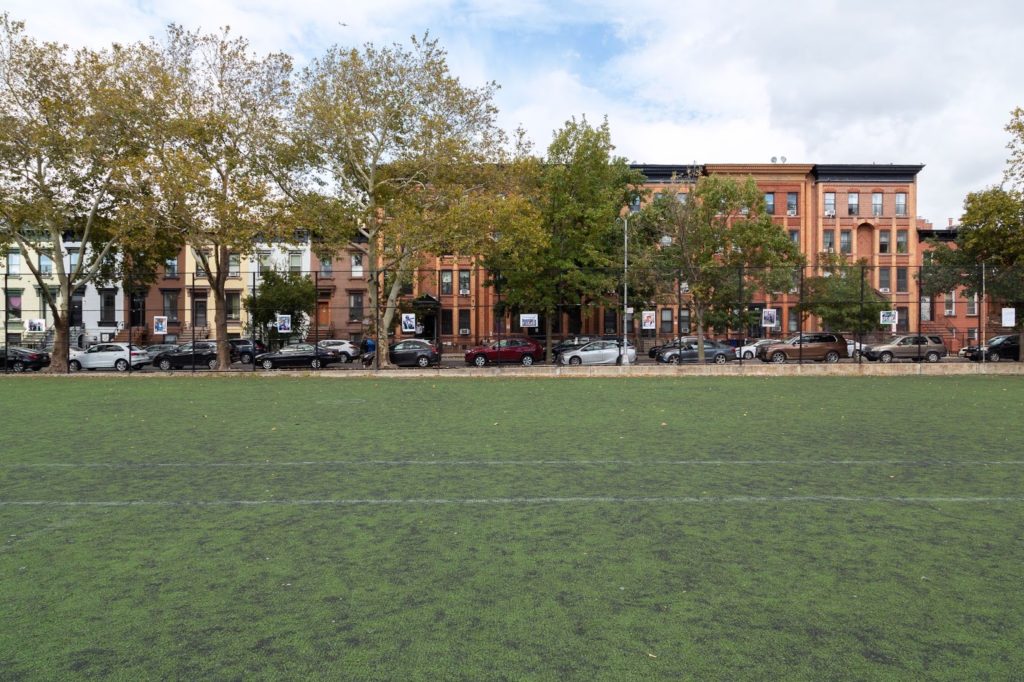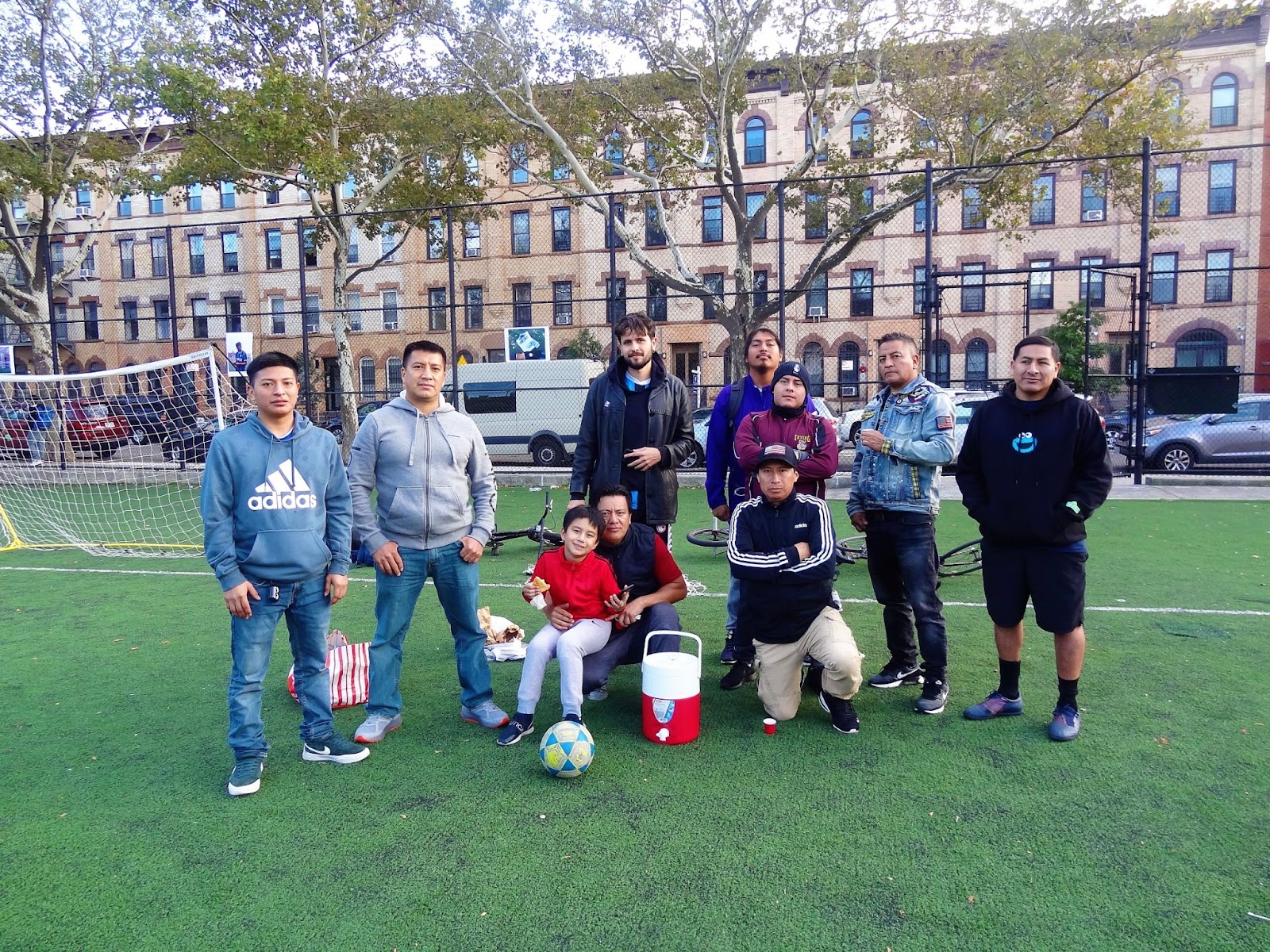It was a cold Sunday afternoon when I first walked up to the soccer field at Reinaldo Salgado Playground, but the sun was bright, its light bouncing off the photographs that now hang inside the gate along the field. It was my first time there, but as I walked along the turf, I was able to see documented memories of games played and portraits of the people who played them. For me, it was like I was in dialogue with the space itself and the community surrounding it.
At Reinaldo Salgado Playground’s field, you can see Mateo Arciniegas Huertas’ art installation “Domingo a las 4,” which showcases what a typical day looks like for a fútbol (soccer in English) player as part of the Inter de Milan team, named after the Italian professional team.
The outdoor exhibit is composed of 16 portraits of teammates and players in the league Liga Gorytos Sports organized by a community member known as “El Profe,” a colloquial term for “the professor.” El Profe and the majority of the players form part of the large Ecuadorian immigrant community in the area.

For Huertas, a Bushwick-based Colombian photographer who has lived in the same apartment for the past six years, it was during the pandemic that he ventured out to learn more about his community and became a frequent player at the Reinaldo Salgado Playground field.
“The importance from this project, it’s like a step closer to achieving that sense of belonging that, I think for a lot of people that come from Latin America, is finding that sense of community,” Huertas told Bushwick Daily. “We as Latinos, we’re very family-oriented. We like to be around people. We’re very warm. We do things with friends and family all the time.”
One of the organizers of the team, Edwin Pullatasig, also known as “Memo” among his community, introduced Huertas to the league in 2020.
“We used to play on the field at Wilson and Knickerbocker and [Huertas] would be sitting there, with the sports clothes. He’d be sitting there and we were in need of a player. So we saw him and said, ‘Come play,’” Pullatasig shared with Bushwick Daily. “And just like that, I told him, ‘let’s go over here, there’s another field where we play by Madison.”

“We just started bonding,” added Huertas. “He’s from Ecuador and I’m from Colombia, so there’s this mutual thing that we share, all of Latin America shares it, I think, but those neighboring countries have little more of a tight bond.”
“I actually haven’t played fútbol before this on a regular basis for years, many years,” Huertas continued. “When I was growing up in Colombia, I was part of a club there, and I would go every weekend and play in a league. It’s kind of the same thing as here you know, train for maybe one or two days of the week. Sunday was the game day for my team and my league when I was growing up.”
The name of the installation, Domingo a las 4 (Sundays at 4) is a nod to the weekly routine of people who come to play fútbol at Reinaldo Salgado.
“Come out to play,” said Pullatasig, “because it’s great. At the moment that you come out to play, you forget everything else, all the worries you’re thinking about, and you feel great.”

The exhibition was done in partnership with ACOMPI, a curatorial project based in New York City, that strives to highlight underrepresented voices and narratives grounded in interdisciplinary practices. The name is a reference to the Spanish word “acompañado,” which means “in company.”
Founders Constanza Valenzuela and Jack Radley shared with Bushwick Daily that Domingo a las 4 was developed with accessibility in mind.
“These photos are completely different in a park where the backdrop is the neighborhood and not in a white space in a small room,” said Valenzuela. “It gives a completely different experience, viewing these images on top of the very Bed-Stuy brownstone architecture and the community. It forces people to engage a little bit further, and that’s why we also wanted Domingo a las 4 to be on the inside of the field so it invites people to come in and not just to walk by.”
According to Huertas, the people who come to watch the games are often families. Many of the vendors during the league are at the field from 10 a.m. to 4 p.m. and sell Ecuadorian food. They typically offer rice, chicken, empanadas, soups and sometimes, canelazo, an alcoholic beverage made with cinnamon and sugarcane, when it’s cold.
The games are a time for community engagement, said Huertas, who shared that he finally feels like he belongs in New York City after ten years in the United States.
“I think as young people, we go from the train to the house, maybe to the local bar, maybe to grab takeout,” said Huertas. “You’re not really engaging with your surroundings and you don’t know your neighbors. Maybe you see your neighbor but do you know their name, do you know where they’re from?”
Huertas and his mother came to the United States seeking asylum from Colombia’s political climate, and he wasn’t able to return to his home country seven years later due to the whole procedure that came with seeking asylum.
“I think that really impacted me and made me think about the diaspora and about being away from home,” said Huertas.
“My work revolves around the question of being, first, Colombian, and being Colombian away from Colombia,” he continued. “I wanted to somehow, within my work, try to give a voice to help people that maybe are not as privileged as we are, and, I think just with my work, I want to show a side of Colombia that is not tragedy and death like what we’re used to seeing.”
You can see more of Huertas’ photography on his website, where he has different series that reflect on his own personal life, including Olvido Pa’ Recordar, which has been shortlisted by the Helsinki Photo Festival. The series began more as a photojournalistic project about Colombia, but then Huertas noticed a shift in the photographs that he was taking.
“I realized through the work that what I really wanted to do, and what these photos are showing, is a really personal story about me and about my journey,” Huertas said, who also shared that he had always struggled with the idea of assimilating to United States culture. “It’s me coming into my cultural identity, trying to find that sense of home that’s not there: how times have changed, family has died, friends have grown older, people I hung out with then I don’t hang out with anymore. I met new people, I relive memories from my home and then I find new ones. There’s always a distance emotionally and geographically that I have with Colombia. Maybe it’s like my fear of realizing that it’s something there that’s very precious to me, but it’s gone. It’s not the same.”
Huertas is seeing that more and more people of different ethnicities are coming to play, because the playground is starting to get a reputation for its competitive games. The games, as well as the art exhibit, are open to the public. Anyone can come to enjoy them. To those that are interested in playing, Huertas says to not be afraid to ask.
Stop by Reinaldo Salgado Playground to see the Domingo a las 4 installation while it’s up (the duration is still undecided) and to catch a game of fútbol.
Three photos from the series will be available for purchase on the ACOMPI website. Ten percent of the proceeds will go to Huertas, who plans to take his team members out to dinner. You can also comment what you think of the Domingo a las 4 exhibition on the ACOMPI Instagram account or email them directly.
“We want feedback and things to be in dialogue,” said Valenzuela.
Quotes by Edwin “Memo” Pullatasig have been translated by the author.
Featured image: Allie Ilaina Herrera
For more news, sign up for Bushwick Daily’s newsletter.
Join the fight to save local journalism by becoming a paid subscriber.



